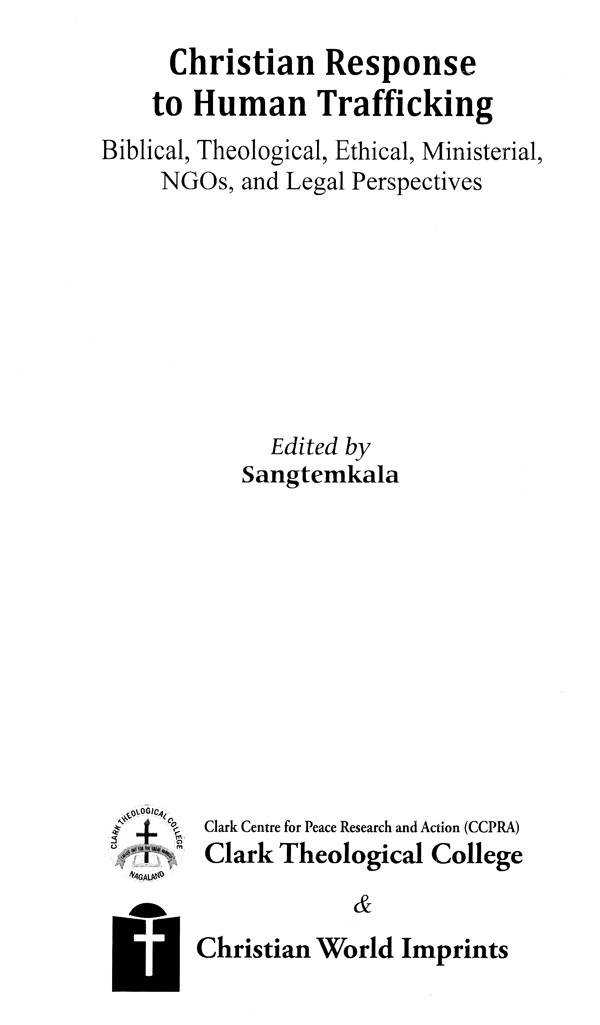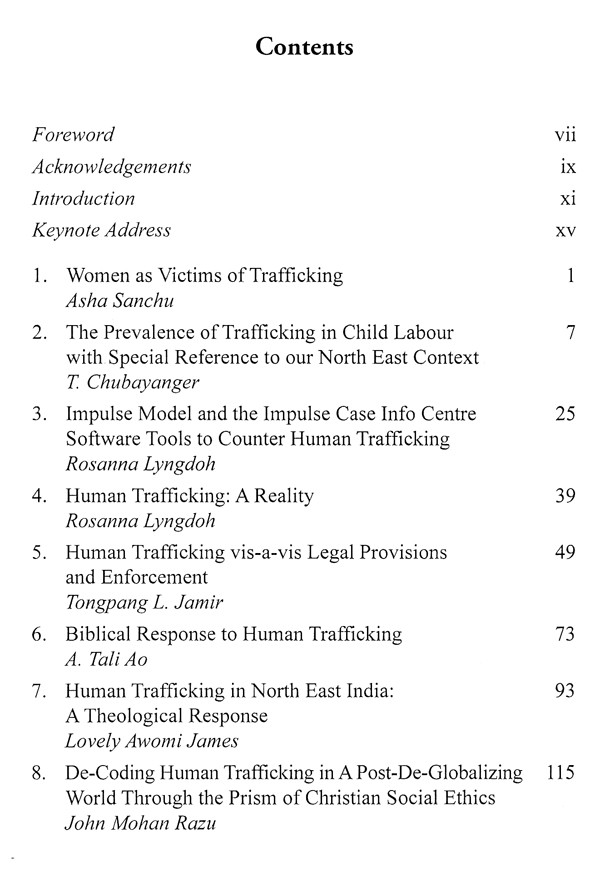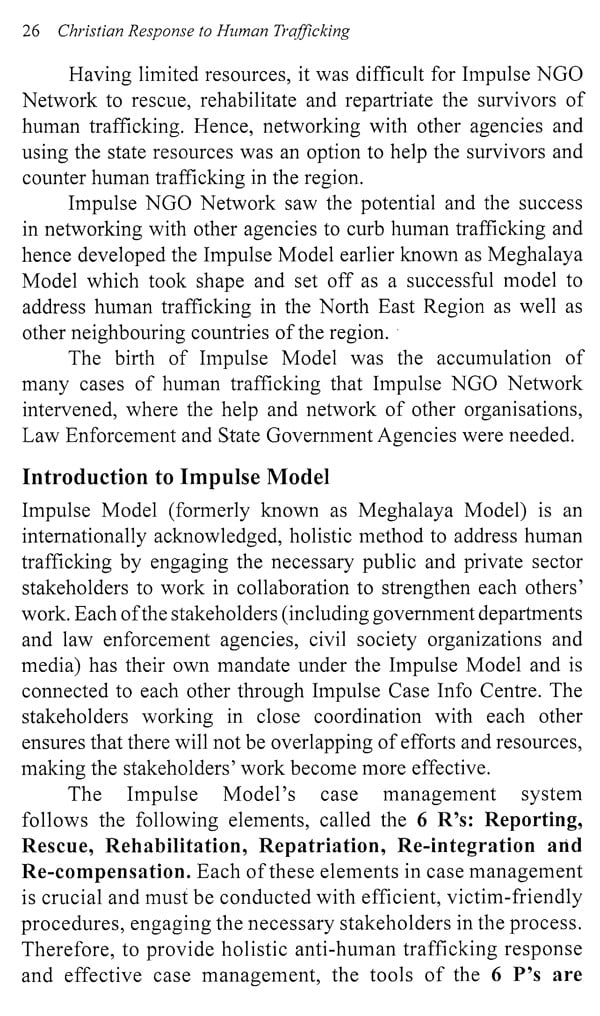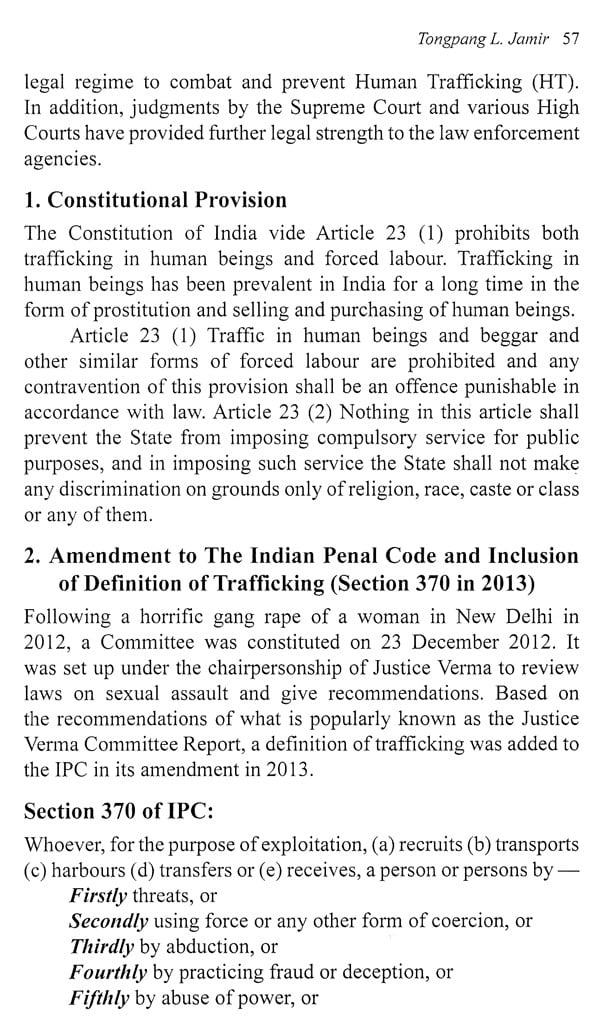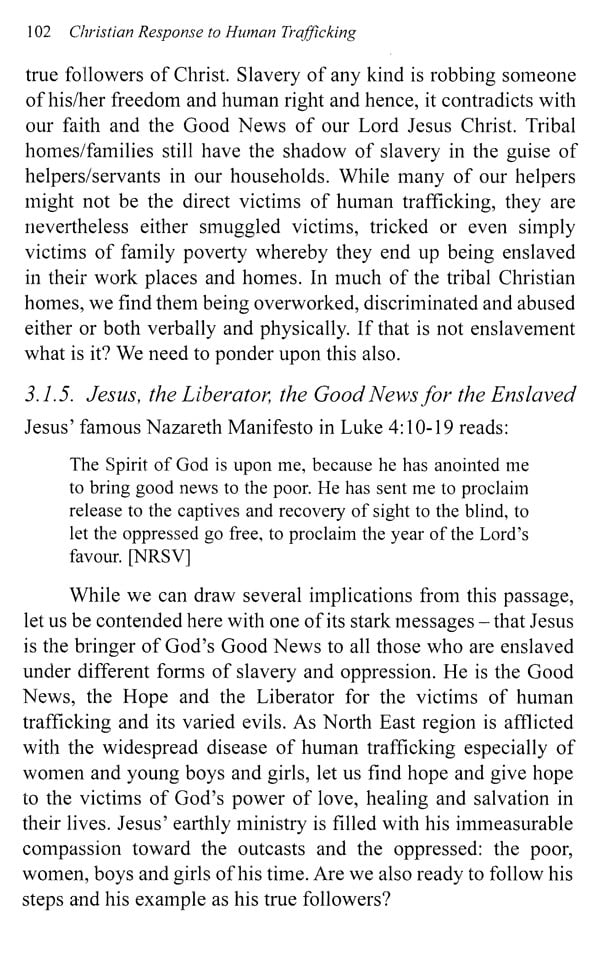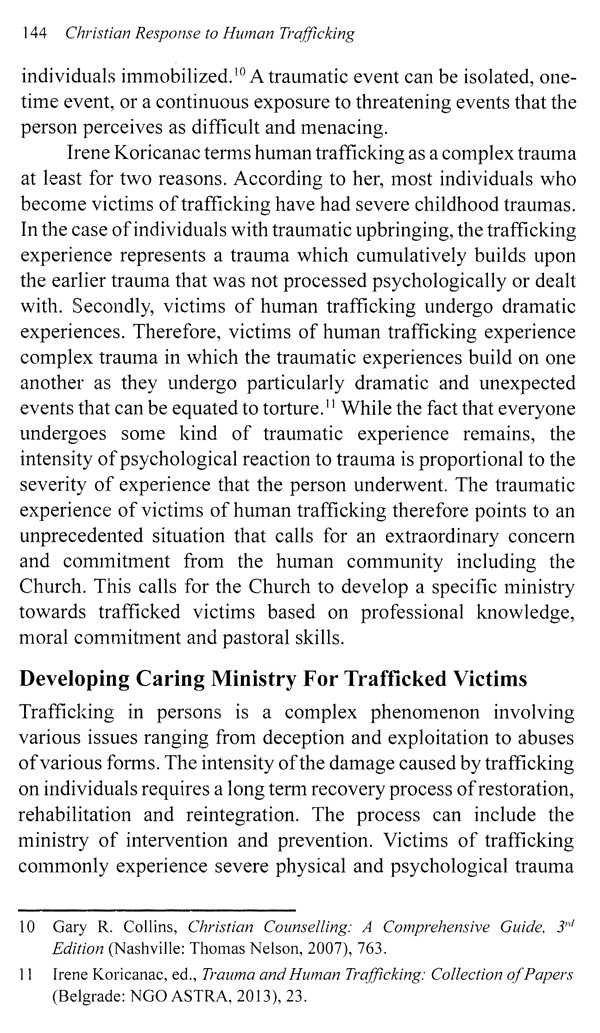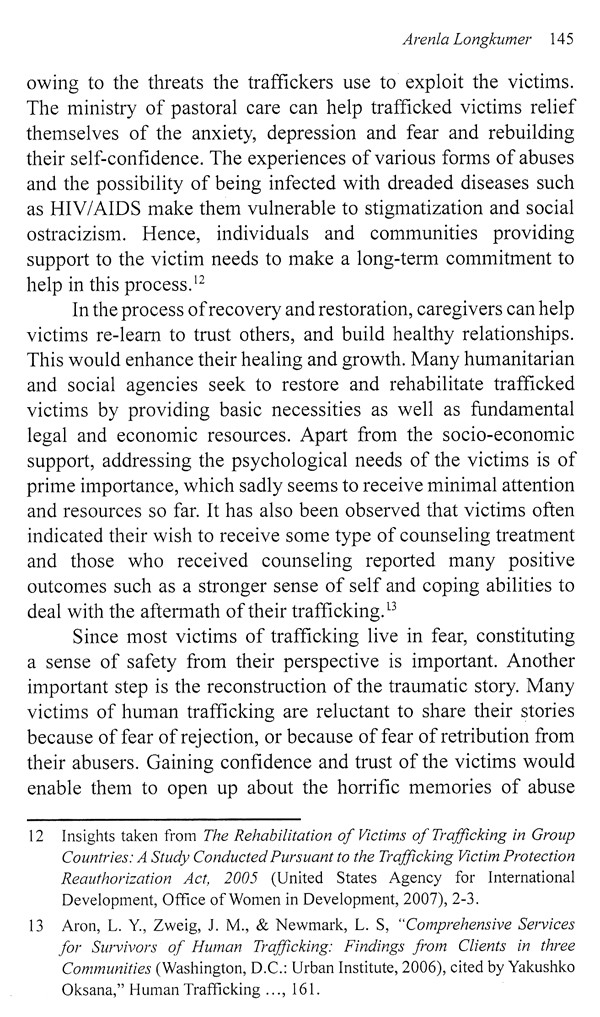
Christian Response to Human Trafficking (Biblical, Theological, Ethical, Ministerial, NGOS, and Legal Perspectives)
Book Specification
| Item Code: | UBA733 |
| Author: | Sangtemkala |
| Publisher: | Clark Theological College & Christian World Imprints |
| Language: | English |
| Edition: | 2020 |
| ISBN: | 9789351484325 |
| Pages: | 181 |
| Cover: | HARDCOVER |
| Other Details | 9.00 X 6.00 inch |
| Weight | 400 gm |
Book Description
This volume takes a fresh look at the issue of human trafficking which is one of the most heinous crimes against humanity today. The essays in this volume represent different disciplines like legal, gender, NGOs, tribals, biblical, theological, ethical, and ministerial perspectives. The research work also attempts to deal with questions such as: what human trafficking is, the causes, and issues involved, how to prevent, rescue, help the victims recover fully, and empower them to enjoy life once again. The intricate nature of the crime requires interdisciplinary approach.
The book appeals to every right thinking citizen and responsible persons to be more sensitive, sensible and perceptive about this reality. This book is meant to be useful for institutions, organizations, state agents, NGOs, ministers, counsellors, researchers, teachers, students and the readers in general. This volume may trigger further discussion and help prevent and combat this menace and help rescue victims, rehabilitate, restore and bring peace and justice to them and society.
Dr. Sangtemkala, for several years, has served as a Child Evangelist and Women Promoter in the Ao Baptist Churches Association, Impur, Nagaland. Presently, she is an Associate Professor and Head of the Department of Christian Theology at the Clark Theological College, Aolijen, Mokokchung, Nagaland.
Living together in peace with one another is the most desired aspiration and of paramount importance for each person in the society. Peace can be disturbed and taken away when the evils of society, like human trafficking, creeps in and operates in the society which especially victimizes and exploits the women, children and weaker sections of the people in the society. According to the United Nations, human trafficking is defined as "The recruitment, transportation, transfer, harboring, or receipt of persons, by means of the threat or use of force or other forms of coercion, of abduction, of fraud, of deception, of the abuse of power or of a position of vulnerability or of the giving or receiving of payment or benefits to achieve the consent of a person having control over another person, for the purpose of exploitation." In fact, human trafficking is a crime and offense which cogently exploits and abuses men, women, children and poor people for commercial purpose. According to report, human trafficking earns global profits of approximately $150 billion a year for traffickers, $99 billion of which comes from commercial sexual exploitation.2 Human trafficking can be seen as modern slavery. Globally, it is estimated that 71% of enslaved people are women and girls, while the remaining 29% are men and boys.' Also, research shows that the mass majority of cases of human trafficking go on undetected because either the cases of trafficking are not reported or distorted.
In India, in general and in Northeast India particularly, there is a high demand for domestic help, cheap labour, and sex workers in urban and commercial sectors that provide opportunity for human trafficking. As a result, many innocent people are being exploited and victimized which bring serious concerns to the church and society.
In view of this present scenario of human trafficking in the society and to address the issues from different perspectives, the Clark Centre for Peace Research and Action (CCPRA) has timely organized the seminar on November 16-18, 2017, on the theme: Human Trafficking: The Dehumanizing Reality. The articles contributed by different scholars from the biblical, theological, legal, ethical and ministerial perspectives will enable the readers to see the dehumanizing reality of human trafficking in the society, which is a global as well as local issue. In addition, it will provide space to give an apt response to human trafficking by engaging in terms of dealing with the prevention of trafficking in person, protection of victims of human trafficking and prosecution of trafficking offenders. As a result, it may have a positive impact in the lives of many of the victims of human trafficking by peace, justice and human dignity. I would like to express my sincere appreciation to Dr. Sangtemkala for taking the trouble of editing this volume. In this connection, I want to thank Miss Imtiwala Imchen, Programme Coordinator, CCPRA, for putting in a lot of effort to bring out this book for readership. I hope that this volume will be a channel of peace for many people in the society who need our attention and support.
A Backdrop Note
Human trafficking is one of the most heinous crimes that has relentlessly violated the very essence of being human. As such, this is a pressing challenge to the global human community's peaceful and meaningful co-existence. This criminal activity diminishes, destroys, and violates human rights, human dignity, and shatters the total life of individuals and communities both at the micro and macro levels across all limits. It is the second most 'profitable' criminal activity (if there is any meaningful profit for any one for that matter) with a tune of a gross eight billion U.S. dollars a year and constantly expanding and multiplying that grows within and beyond all limits of boundaries and borders.In order to address and initiate various responses to this challenging issue and related problems, a National Seminar on the theme: 'Human Trafficking: The Dehumanizing Reality', was organized by the Clark Centre for Peace and Research Action of the Clark Theological College, which was held from 16-18, November 2017 at Aolijen, Mokokchung, Nagaland. The papers in this volume were presented at that Seminar. They represent a wide range of lived experiences and expertise that directly deal with questions such as, what is human trafficking, what are the root causes and effects, who and what does it involve, and perhaps most importantly, how should we as Church, institutions, organizations and Christians respond to this variegated crime commonly called the modern slavery?
Highlights of the Chapters
The Keynote Address by Asha Sanchu traces human trafficking as far back as the Joseph story which could be the first trafficked man in the Bible. Then, in the first chapter she argues that women and young girls are the most vulnerable targeted victims of human trafficking in the North East India which is the result of all the evils of gender inequality in our society. This evil is further accentuated by the factors of protracted political unrest across the interstate and international borders which is then abetted and aggravated by economic instability, and the ever growing depression and anxiety. over the problem of unemployment and better opportunities for healthy and meaningful life.In the second chapter, T. Chubayanger deals with prevalence of trafficking associated with child labour in our region from a legal point of view. His paper supplies various Homes and Centres as well as some helpful statistics on the problems of human trafficking. He argues that despite various international conventions, constitutional and legal provisions and acts for prevention and protection of children at risk the criminal acts of child and young people trafficking continues unabated in our region due to ever increasing migrations from economically. backward village areas to cities and urban townships seeking for works. This eventually lands up many children and young people as easy targets for human trafficking in different forms involving criminals and even unexpected channels such as relatives, friends, people known to them and even their parents.
In chapter three, Rosanna Lyngdoh brings in her experiences of using the Impulse Model used in the Impulse Case Info Centre Software Tools based in Shillong, Meghalaya, India to counter human trafficking. She provides several different cases of trafficked victims and the whole network systems in the North East and the mainland India which emerged and developed over the years and helped rescue, rehabilitate and repatriate the survivors by networking with related agencies availing state resources and other options to help the survivors and to counter human trafficking in the region. In chapter four, she also discusses the reality of human trafficking in India with a particular focus on North East India specifically that touches on the problems faced by women and children of all sexes.
**Contents and Sample Pages**
